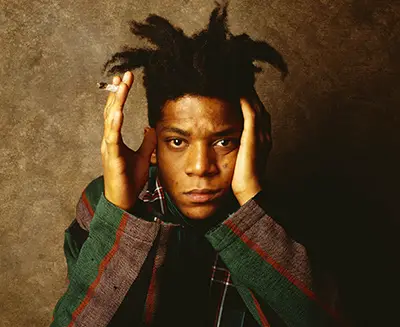While his impact upon art cannot be denied, he also led a short life with a rather tragic ending. Let us look at a brief biography of his art as well as his life.
Early Life
Basquiat was born on 22 December 1960 in Brooklyn, New York. His mother was of Haitian descent and his father was Puerto Rican. He also had two younger sisters. From an early age, his mother encouraged him to appreciate the arts by regularly taking him to museums throughout Manhattan. It was also noted that he was quite gifted from a very early age. Basquiat supposedly learned to read and write when he was only four years old. He could speak French, Spanish and English well before his teenage years. He soon turned this formidable intelligence towards art.
He was enrolled in the Brooklyn Museum of Art (as a junior member) and when he was only seven, he began studying in a prestigious art school near his home. It was here that he entered into his first real artistic endeavour. Along with a classmate, he published a short children's book. Basquiat also began developing a talent for athletics; particularly in track and field events.
Things took a dramatic turn when he was struck by a car at the age of eight. He suffered from a broken arm and various internal injuries. To keep him occupied during convalescence, his mother bought him a copy of Gray's Anatomy. It is thought that this single book would later prove to have a palpable influence upon his art as an adult.
Unfortunately, troubles soon began to mount. His mother had been known to suffer from bouts of depression and she was committed to a psychiatric institution when he was 13. This pattern was set to continue for some time. When Basquiat was 15 years old, he left home and spent time sleeping on park benches. Police eventually located him and placed him under the care of his father. Soon after, he dropped out of school. This caused a major rift with his father and he was banished from home entirely. The only resort was to sleep at the homes of his various friends. It is said that he earned money by designing t-shirts and selling handmade postcards during his spare time.
Early Career and Musical Ventures
Basquiat first began to earn a reputation as a graffiti artist when he was still living on the Lower East Side of New York City. Using the pen name SAMO, he would "tag" various buildings with enigmatic statements such as "Plush safe he think...SAMO". These expressions along with his personal style would have a massive impact upon his later career. He also worked as an employee at a retail store by the name of Unique Clothing Warehouse during this time.
He befriended fellow artist Glenn O'Brien and he would make regular appearances on his show TV Party over the next few years. Basquiat took a brief foray into the world of music; forming the band Gray (perhaps a tribute to the influence of Gray's Anatomy). He played numerous gigs throughout 1979 and 1980.
It is also interesting to note that Basquiat would play a role in the independent film Downtown 81 (a production of O'Brien). One evening, he met famed artist Andy Warhol at a restaurant. He showed Warhol some of his work and it is said that he was taken aback by the sense of genius and originality that Basquiat exhibited at such a young age. The two would later collaborate on several projects.
The Breakthrough Years
The first half of the 1980s proved to be very productive for young Basquiat. He would participate in The Times Square Show in 1980; an event sponsored by both Fashion Moda and Collaborative Projects Incorporated. In 1980, he became a member of the Annine Nosei gallery and produced his first one-man show with great success in the basement of the building. He gained further attention when an article entitled "The Radiant Child" was published on his work. This could arguably be seen as the first time that he enjoyed positive attention from the mainstream world of art.
He travelled to Italy in 1982 before returning back to the United States to live with his friend Larry Gagosian in Venice, California. He displayed a number of paintings at the Gagosian Gallery in 1983 and dated the then-unknown singer Madonna for some time. Basquiat also became interested in the artistic style of Robert Rauschenberg. He was said to have been inspired by the mainstream success of this artist. He briefly worked with musician David Bowie during this time as well.
Perhaps as a result of his exposure to music while in California, Basquiat went on to produce a 12-inch hip-hop single. While the album was only distributed in limited quantities, it displayed his own artwork. This was thought to generate more interest in his unique style. These albums are highly valued by collectors today.
Between 1983 and 1985, Basquiat and Warhol enjoyed a fruitful and collaborative relationship. They also cemented a lasting friendship. One example of their synergy can be seen in the painting Olympic Rings. While the original piece displayed the traditional Warhol style, Basquiat went on to produce a more stylised version through the use of his trademark graffiti illustrations. Perhaps as an influence from Warhol himself, Basquiat had the habit of painting in very expensive Armani suits. He would often be seen in public wearing these very same paint-splattered clothes.
Notable Exhibitions
As mentioned previously, the first major exhibition which showcased the work of Basquiat was The Times Square Show. Other artists who participated included Jenny Holzer, David Hammons and Kiki Smith. He enjoyed particular success with his European audience. Major exhibitions were held in Hannover (1987), Edinburgh (1984), Rotterdam and London (both in 1985). Bruno Bischofberger was his primary European representative. These shows took place simultaneously with displays at the Gagosian Gallery in California. The height of his fame peaked in 1985 when he was featured on the front page of The New York Times Magazine. The article was entitled "New Art, New Money: The Marketing of an American Artist". Unfortunately, this was also the same time that Basquiat was becoming highly addicted to heroin.
The Final Events Leading up to His Death
Many contemporaries observe that the death of Andy Warhol in 1987 had a profound effect upon the demeanour and emotional state of Basquiat. He became depressed more frequently and as a result, his use of heroin increased. It should still be mentioned that he made several attempts to become sober; the final effort during a trip to Hawaii. He died of a heroin overdose on 12 August 1988. At the time, he was only 27 years old.
Styles and Methods
Basquiat was known for depicting the head of his subjects as opposed to their entire bodies. Many contemporary critics also believed that his use of "heroic" figures and icons further defined his style; an approach that was (for the most part) entirely his own.
Another defining trait of Basquiat is that he would often incorporate words, anagrams, figures and numbers into his drawings. This is likely due to the fact that he was heavily influenced by his early days as a graffiti artist on the streets of New York. It should be mentioned that the book Gray's Anatomy had an equally profound influence upon his style; particularly when drawing the human form.
Influences Upon Black Heritage
Another very important facet of his work revolves around the concept of African-American heritage. Although not ss overtly seen when compared to some of his contemporaries, there is no doubt that this notion played an important role. One major example can be seen in a painting known as Untitled. This work depicts an Egyptian boat sailing upon the Nile River. The words "esclave, slave, esclave" are written in the background and "Nile" is crossed out and rewritten again. Many feel that this was intended to symbolise the fact that history was scribed by the winners and the truth was merely a perspective. Another point to mention here is that this may also be a reference to black Egyptians enslaving other blacks; a topic rarely touched upon during the 1970s and 1980s.
A similar theme can be seen in Irony of a Negro Policeman (1981). As opposed to serving public interests, Basquiat felt that blacks should instead be helping to better the black community as a whole. The term "Uncle Tom" may even be used here although the artist himself never directly referred to such a concept. However, the fact that the policeman was depicted as a black man wearing a white mask illustrated that he indeed embraced such a view. A hat resembling a cage further reinforces his views on the post-segregation era. Such beliefs may have arisen out of his experiences in New York City as a teenager and a young adult.
Overall Interpretations
Notwithstanding the racial undertones of some of his work, many others have noted some more general characteristics. In her book Lost in Translation, author Kellie Jones notes that his works represent a mischievous and complex nature. She also rightly points out that this is sometimes overlooked as a result of his views on the African-American culture (1). Others state that his pieces hint at a slight vulnerability. Their fragmented, broken and scarred appearances allude to the fact that he may have been feeling slightly out of place himself.
Legacy and Subsequent Success
Like many young artists, the ultimate irony was that the genius of his work would be fully recognised years after his death. Many prominent rap artists paid homage to Basquiat during the late 1980s and early 1990s. These include the band In Living Color, Jay Z, Frank Ocean, Kanye West, J. Cole and many others. Some of his work has also been featured within the world of fashion.
The works of Basquiat have likewise enjoyed a great deal of critical acclaim since his death in 1988. For instance, the total value of his works is now thought to be somewhere in the realm of $115 million dollars. His painting Profit I (1982) sold for an impressive $5,509,500 dollars in 2002. In 2008, Boxer (1982) was auctioned off by Christie's for a price of no less than $13,522,500 dollars. In 2016, an untitled painting was sold to a Japanese collector for the sum of $57.3 million dollars. This is the most expensive sale to date.
As can be seen in this brief biography, there is no doubt that Basquiat played a pivotal role in the emerging urban art culture of the 1970s and 1980s. His use of graffiti within many of his pieces separated him from others while the influence of Andy Warhol played an equally significant role. Although he died at only 27 years of age, it is undeniable that Jean-Michel Basquiat has made a lasting impact upon the modern art scene.
Sources:
1. Lost in Translation: Jean-Michel in the (Re)Mix, by Kellie Jones, from the book Basquiat, edited by Marc Mayer, 2005, Merrell Publishers in association with the Brooklyn Museum


